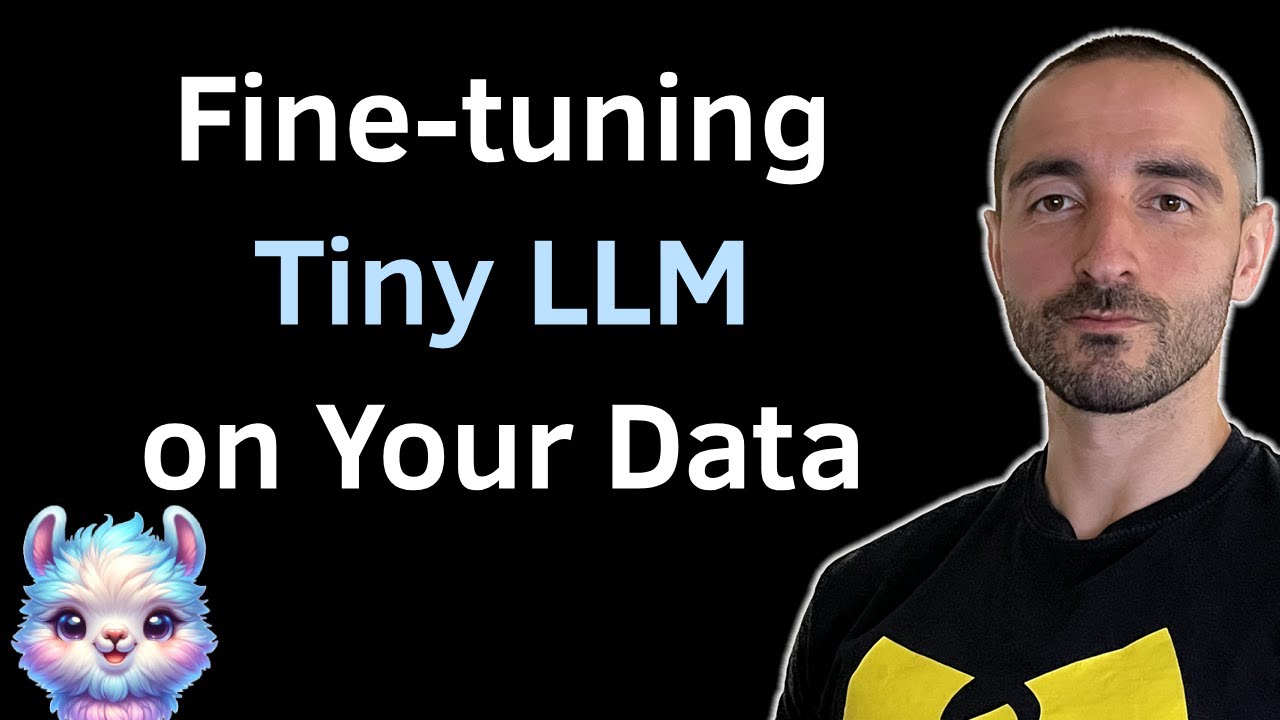Fine-Tune Your Own Tiny-Llama on Custom Dataset
Summary
TLDRThis video tutorial demonstrates how to fine-tune the Tiny Lama language model on a specific dataset to predict color hexadecimal codes from descriptions. It uses the 'colors' dataset from Hugging Face and guides viewers through the process of formatting data, setting up the model, and training with the PFT package. The video highlights the model's ability to perform the task without explicit instructions, showcasing its potential for edge devices and emphasizing the advancements in small language models.
Takeaways
- 😀 The video discusses fine-tuning the Tiny Lama language model on a specific dataset for a particular task.
- 🔍 Tiny Lama is a small language model not ideal for general language tasks but can be fine-tuned for specific tasks and run on edge devices.
- 🌟 The video is inspired by a blog post by Min Yang Chien about fine-tuning Tiny Lama with a color dataset.
- 📚 The color dataset from Hugging Face contains color descriptions and corresponding hexadecimal codes.
- 💡 The goal is to train Tiny Lama to generate a hexadecimal code from a color description without additional instructions.
- 🛠️ The process involves using packages like 'accelerate', 'bitsandbytes', 'transformers', and 'trl' for fine-tuning.
- 📝 The dataset is formatted in a 'chat ml' format, which is the default for Tiny Lama's chatbot version.
- 🔧 The model is set up using the 'PFT' package and 'Aura' adapters, which are fine-tuned instead of the original model.
- 🔑 The training parameters, including learning rate and batch size, are crucial for the model's performance and need to be experimented with.
- 📉 The training process involves monitoring the loss, which should decrease over time, indicating the model is learning.
- 🚀 After training, the Aura adapters are merged with the original model to create the final model for inference.
- 🎯 The model's inference capability is demonstrated by generating a hexadecimal code for a given color description, showing quick and accurate results.
Q & A
What is the purpose of fine-tuning the Tiny Lama model?
-The purpose of fine-tuning the Tiny Lama model is to adapt it for very specific tasks, making it capable of running on edge devices and performing specialized functions like generating hexadecimal color codes from color descriptions.
What is the 'colors' dataset used in the video?
-The 'colors' dataset is a resource from Hugging Face that contains two columns: 'description' which provides a description of a color, and 'colors' which is the corresponding hexadecimal code.
Why is the Tiny Lama model not suitable for general language tasks?
-The Tiny Lama model is not suitable for general language tasks because it is a very small model, designed for specific tasks rather than broad language understanding or generation.
What is the role of the 'description' column in the 'colors' dataset?
-The 'description' column in the 'colors' dataset serves as the input for the model, describing a color in text form for the model to learn and generate the corresponding hexadecimal code.
How does the fine-tuning process differ from using a large language model with prompting?
-The fine-tuning process involves training the model on a specific dataset without the need for explicit instructions for each task, unlike prompting a large language model which requires direct instructions for each color description to generate a hexadecimal code.
What is the significance of the 'text' column in the formatted dataset?
-The 'text' column is critical as it combines the input and response in the correct format for training. It uses a prompt template to prepare the data for the model to learn the association between color descriptions and hexadecimal codes.
What is the role of the 'accelerate' and 'bitsandbytes' packages in the fine-tuning process?
-The 'accelerate' package is used to facilitate the fine-tuning process, while 'bitsandbytes' is a library that provides efficient handling of model training and tokenizers, especially for models like Tiny Lama.
How does the model generate the hexadecimal code without explicit system instructions?
-After fine-tuning, the model learns to associate color descriptions with their hexadecimal codes. It generates the code by processing the input description without needing further instructions, showcasing the model's adapted capabilities.
What is the importance of the 'max_sequence_length' parameter in the training setup?
-The 'max_sequence_length' parameter is important as it defines the maximum length of the input sequences the model can process. It is set to accommodate the length of the data in the 'colors' dataset and the model's capacity.
How does the model's performance in generating color codes reflect its learning?
-The model's performance is demonstrated by its ability to quickly and accurately generate hexadecimal color codes that closely match the provided color descriptions, indicating that it has effectively learned from the fine-tuning process.
What does the video suggest about the future of small language models?
-The video suggests that small language models like Tiny Lama are promising for the future, particularly for tasks that require running on consumer hardware or edge devices, and we can expect to see more advancements in this area in 2024.
Outlines

このセクションは有料ユーザー限定です。 アクセスするには、アップグレードをお願いします。
今すぐアップグレードMindmap

このセクションは有料ユーザー限定です。 アクセスするには、アップグレードをお願いします。
今すぐアップグレードKeywords

このセクションは有料ユーザー限定です。 アクセスするには、アップグレードをお願いします。
今すぐアップグレードHighlights

このセクションは有料ユーザー限定です。 アクセスするには、アップグレードをお願いします。
今すぐアップグレードTranscripts

このセクションは有料ユーザー限定です。 アクセスするには、アップグレードをお願いします。
今すぐアップグレード関連動画をさらに表示

Fine-tuning Tiny LLM on Your Data | Sentiment Analysis with TinyLlama and LoRA on a Single GPU

Finetuning of GPT 3 Model For Text Classification l Basic to Advance | Generative AI Series

"okay, but I want GPT to perform 10x for my specific use case" - Here is how

Step-by-Step Handwriting Recognition Tutorial Using TensorFlow

EASIEST Way to Fine-Tune a LLM and Use It With Ollama

YOLO World Training Workflow with LVIS Dataset and Guide Walkthrough | Episode 46
5.0 / 5 (0 votes)
